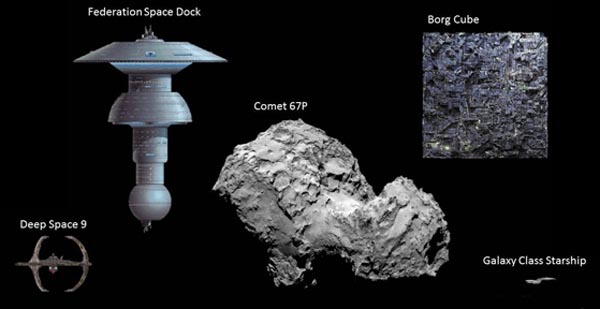November 15, 2014
Why landing a space vehicle on a comet is such an amazing achievement

To get a true appreciation for the scientific feat accomplished with the landing of a space vehicle on a comet, you have to wrap your mind around two astonishing facts — the vastness of the space between here and there, and tininess of the comet itself.
I found two websites that a great job of this.
The first, created by Josh Worth, is called If the Moon Were Only One Pixel: A Tediously Accurate Scale Model of the Solar System. Be prepared to do a lot of horizontal scrolling without much to see but a few minuscule dots in a sea of black. Luckily, the tedium is broken up with the occasional witty observation.
Bearing in mind that the moon is only one pixel in Worth’s model, it would still dwarf Comet 67P/Churyumov–Gerasimenko. The moon is 3,475 kilometres in diameter while the comet is a mere four kilometres across. To put it in terms that Star Trek fans would understand, it’s not much bigger than a Federation Space Dock.
What would that look like? As it turns out, Christopher Becke, a high school physics teacher, has created graphics (like the one above) showing not only Star Trek comparisons, but also other science fiction and more reality-based comparisons. The comet could, for example, fit in Manhattan.
One way to think of it would be to imagine two specks of sand a mile apart with nothing in between them. Some microbes on one speck somehow figure out that the other speck exists and fire off a microbe-sized vehicle to hit the other speck. Complicating matters, the two specks are in constant motion at different rates of speed.
And of course there’s that time thing. If you shoot an arrow from a bow, you’ll generally know within seconds whether you have hit your target. But with the comet, scientists had to wait 10 years before knowing whether they reached their goal. And even then they didn’t exactly hit it — they came really close and soft-landed Philae on the surface. Remember when the new version of Battlestar Galactica started up on TV? That’s when this mission began.
Speaking of time, we should also be aware of old the comet is. The pictures transmitted back to Earth may be showing leftover rocks dating from the formation of the solar system 4.6 billion years ago. How old is that? According to the Cosmic Calendar, if you compressed the history of the universe (13.8 billion years) into a year-long calendar, the solar system would have shown up on Aug. 31. Our age of modern science wouldn’t appear up until Dec. 31 at one second before midnight.
As if the photos posted by the European Space Agency on Flickr weren’t breath-taking enough, the story behind how they came to be makes them all the more remarkable.
